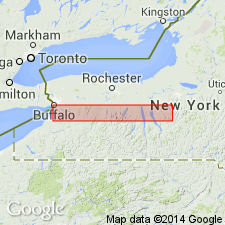
- Usage in publication:
-
- Athol Springs bed
- Athol Springs limestone bed
- Modifications:
-
- Named
- Dominant lithology:
-
- Limestone
- AAPG geologic province:
-
- Appalachian basin
Summary:
Name Athol Springs bed of Kloc (1983, SUNY MS thesis) is here "formalized and adopted for usage." Type locality described on Lake Erie shore where unit forms a resistant limestone cap 10 to 15 cm thick on wave-cut cliff. Ripple-marked upper surface is covered by STYLIOLINA. Unit is characterized by planispiral gastropod STRAPAROLLUS, which is nearly unique to this horizon. This marker bed has long been recognized and was referred to as the "PTEROPOD bed" by Grabau (1899), the "PHANEROTINUS bed" by Cooper (1929), and the "STRAPAROLLUS bed" by McCollum (1980, PhD. dissert.). Athol Springs forms the uppermost bed of the newly named Winspear submember [informal] of the Ledyard Member of the Ludlowville Formation. Above the Athol Springs is the newly named Elma submember [informal]. Age is Middle Devonian.
["Submember" not recognized as a formal stratigraphic rank term (CSN, 1933; ACSN, 1961, 1970; NACSN, 1983, 2005). Considered informal until formally published. The rank or lithologic term should not be capitalized.]
Source: GNU records (USGS DDS-6; Reston GNULEX).
For more information, please contact Nancy Stamm, Geologic Names Committee Secretary.
Asterisk (*) indicates published by U.S. Geological Survey authors.
"No current usage" (†) implies that a name has been abandoned or has fallen into disuse. Former usage and, if known, replacement name given in parentheses ( ).
Slash (/) indicates name conflicts with nomenclatural guidelines (CSN, 1933; ACSN, 1961, 1970; NACSN, 1983, 2005, 2021). May be explained within brackets ([ ]).

